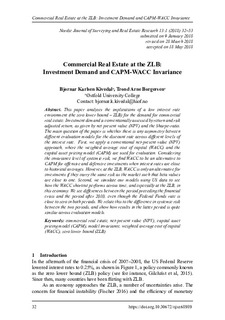| dc.contributor.author | Kivedal, Bjørnar Karlsen | |
| dc.contributor.author | Borgersen, Trond Arne | |
| dc.date.accessioned | 2018-11-23T15:30:19Z | |
| dc.date.available | 2018-11-23T15:30:19Z | |
| dc.date.created | 2018-08-17T09:00:52Z | |
| dc.date.issued | 2018 | |
| dc.identifier.citation | Nordic Journal of Surveying and Real Estate Research. 2018, 13 (1), 32-53. | nb_NO |
| dc.identifier.issn | 1459-5877 | |
| dc.identifier.uri | http://hdl.handle.net/11250/2574677 | |
| dc.description.abstract | This paper analyzes the implications of a low interest rate environment (the zero lower bound – ZLB) for the demand for commercial real estate. Investment demand is conventionally assessed by return and risk adjusted return, as given by net present value (NPV) and the Sharpe-ratio. The main question of the paper is whether there is any asymmetry between different evaluation models for the discount rate across different levels of the interest rate. First, we apply a conventional net-present value (NPV) approach, where the weighted average cost of capital (WACC) and the capital asset pricing model (CAPM) are used for evaluation. Considering the invariance level of systemic risk, we find WACC to be an alternative to CAPM for offensive and defensive investments when interest rates are close to historical averages. However, at the ZLB, WACC is only an alternative for investments if they carry the same risk as the market such that beta values are close to one. Second, we simulate our models using US data to see how the WACC shortcut performs across time, and especially at the ZLB, in this economy. We see differences between the period preceding the financial crisis and the period after 2010, even though the Federal Funds rate is close to zero in both periods. We relate this to the difference in systemic risk between the two periods, and show how results in the latter period is quite similar across evaluation models. | |
| dc.language.iso | eng | nb_NO |
| dc.publisher | The Finnish Society of Built Environment Research | nb_NO |
| dc.subject | commercial real estate | nb_NO |
| dc.subject | net-present value (NPV) | nb_NO |
| dc.subject | capital asset pricing model (CAPM) | nb_NO |
| dc.subject | model invariance | nb_NO |
| dc.subject | weighted average cost of capital (WACC) | nb_NO |
| dc.subject | zero lower bound (ZLB) | nb_NO |
| dc.title | Commercial Real Estate at the ZLB: Investment Demand and CAPM-WACC Invariance | nb_NO |
| dc.type | Journal article | nb_NO |
| dc.type | Peer reviewed | nb_NO |
| dc.description.version | publishedVersion | nb_NO |
| dc.source.pagenumber | 32-53 | nb_NO |
| dc.source.volume | 13 | nb_NO |
| dc.source.journal | Nordic Journal of Surveying and Real Estate Research | nb_NO |
| dc.source.issue | 1 | nb_NO |
| dc.identifier.doi | 10.30672/njsr.68989 | |
| dc.identifier.cristin | 1602559 | |
| cristin.unitcode | 224,60,0,0 | |
| cristin.unitname | Avdeling for økonomi, språk og samfunnsfag | |
| cristin.ispublished | true | |
| cristin.fulltext | original | |
| cristin.fulltext | This paper analyzes the implications of a low interest rate environment (the zero lower bound – ZLB) for the demand for commercial real estate. Investment demand is conventionally assessed by return and risk adjusted return, as given by net present value (NPV) and the Sharpe-ratio. The main question of the paper is whether there is any asymmetry between different evaluation models for the discount rate across different levels of the interest rate. First, we apply a conventional net-present value (NPV) approach, where the weighted average cost of capital (WACC) and the capital asset pricing model (CAPM) are used for evaluation. Considering the invariance level of systemic risk, we find WACC to be an alternative to CAPM for offensive and defensive investments when interest rates are close to historical averages. However, at the ZLB, WACC is only an alternative for investments if they carry the same risk as the market such that beta values are close to one. Second, we simulate our models using US data to see how the WACC shortcut performs across time, and especially at the ZLB, in this economy. We see differences between the period preceding the financial crisis and the period after 2010, even though the Federal Funds rate is close to zero in both periods. We relate this to the difference in systemic risk between the two periods, and show how results in the latter period is quite similar across evaluation models. | en |
| cristin.qualitycode | 1 | |
